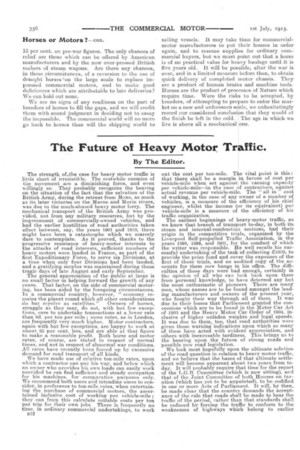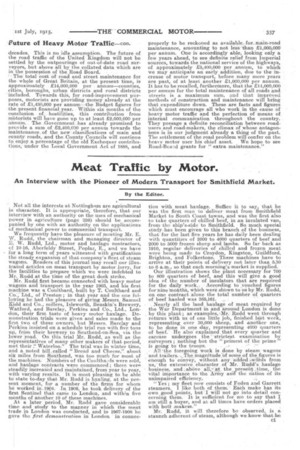The Future of Heavy Motor Traffic.
Page 2

Page 3

If you've noticed an error in this article please click here to report it so we can fix it.
By The Editor.
The strength of ,the ease for heavy motor traffic is little short of irresistible. The erstwhile enemies of the movement are a diminishing force, and even willingly so. They probably recognize the bearing on the situation of the fact that the salvation of the British Army, during the retreat from Mons,. as much as its later victories on the Marne and Morin rivers, was due to the much-abused heavy motor lorry. The mechanical transport of the British Army was provided, not from any military resources, but by the impressment of commercially-owned vehicles, and had the earlier hostilities of road authorities taken effect between, say, the years 1901 and 1910, there might have been a catastrophe which we scarcely dare to contemplate. As it proved, thanks to the progressive resistance of heavy-motor interests to the attacks of road interests, sufficient numbers of heavy motors were landed in France, as part of the first Expeditionary Force, to serve six Divisions, at a time when only four Divisions had been landed, and a gratifying surplus was maintained during those tragic days of late August and early September.
The general appreciation of the public at large is DO small factor in helping forward the growth of any cause. That factor, on the side of commercial motoring, has been aided by the foregoing circumstances. In .a commercial country, however, " economy remains the planet round which all other considerations do but revolve as satellites." Owners of horses, struggle as they may, do not, with but few exceptions, care to undertake transactions at a. lower rate than 8d. per ton per mile ; some rates, as in London, are frequently very much higher. Motor contractors, again with but few exceptions, are happy to work at about 35 per cent, less, and are able at that figure to make a reasonable profit. Both horse and motor rates, of course, are stated in respect of normal times, and not in respect of abnormal war conditions. All rates have recently been forced up by excessive demand for road transport of all kinds.
We have made use of relative ton-mile rates, upon which a contractor can pay his way, and below which an owner who provides his own loads can easily work provided be can find sufficient and steady occupation for his machines, for comparative purposes only. We recommend both users and intending users to consider, in preference to ton-mile rates, when entertain ing the inclusive cost of commercial motors, the ascer tained cost of working per vehicle-mile ; they can from this calculate suitable costs per ton per trip for their own jobs. There is frequently no time, in ordinary commercial undertakings, to work B12 out the cost per ton-mile. The vital point is this : that there shall be a margin in favour of cost per vehicle-mile when set against the earning capacity per vehicle-mile—in the case of contractors, against actual revenue per vehicle-mile. The " all in" cost of working, in the case of any owner of a number of vehicles, is a measure of the efficiency of his chief engineer, _whilst the income (or its equivalent) per
is a measure of the efficiency of his traffic organization.
The earliest beginnings of heavy-motor traffic, as we know that branch of transport to-day, in both its steam and internal-combustion sections, had their origin in the competitive trials, organized by the Liverpool Self-propelled Traffic Association, in the years 1398, 1899, and 1901, for the conduct of which the writer was responsible. He well recalls his successful undertaking of the task of collecting 21000, to provide the prize fund and cover the expenses of the first of those trials, and an audited copy of the accounts for them now hangs in his office. The difficulties of those days were bad enough, certainly in the opinion of all who can look hack upon them from personal knowledge, to have deterred any but the most enthusiastic of pioneers. There are many men, whose names are to be found amongst the leading manufacturers and owners of the present year, who fought their way through all of them. It was due to their losses that Parliament granted the concessions which are to be found in the Motor Car Act of 1903 and the Heavy Motor Car Order of 1904, inelusive of higher unladen weights and legal. speeds. It was due to them, too, that road authorities were given those warning indications upon which so many of them have acted with evident appreciation, and others with inexcusable tardiness. This brings us to the bearing upon the future of strong roads and possible new road legislation. We look most hopefully upon the ultimate solution of the road question in relation to heavy motor traffic, and We believe that the bases of that ultimate settlement will become apparent about two years from to day. It will probably require that time for the report of the L.G.B. Committee (which is now sitting), arid that of the Joint Committee of both Houses on taxation (which has yet to be appointed), to he codified in one or more Acts of Parliament. It will, by then, be made clear that the country demands the acceptance of the rule that roads shall be made to bear the traffic of the period, rather than that standards shall be reduced by forcing the traffic to conform to the weaknesses of highways which belong to earlier decades. This is no idle assumption. The future of the road traffic of the United Kingdom will not be settled by the outpourings of out-of-date road surveyors, but above all by the collated data which are in the possession of the Road Board. • .
The total . coat of road and street maintenance for the -whole of Great Britain, at the present time, is approximately £14,000,000 per . annum—counties, ethos, boroughs, urban districts and rural districts ' included. Towards this, for road-improvement purposes, motorists are providing money already at the rate of £1,430,000 per annum—the Budget figures for ake.present financial year. Within six months of the conclusion of,. hostilities, this contribution from Mbtorists will have gone up to at least £2,000,000 per arinuin. The .Government has already promised to provide a sum of -£2,400,000 per annum towards the maintenance; of the new: classifications of main and county roads,. and the County. Councils will continue to enjoy_a percentage of the old Exchequer contributions, under the Local Government Act of 1888, and properly to be reckoned as available_ foraniain-road maintenance, amounting to not less -than £1,000,000 per annum. One is accordingly able, looking only a few years ahead, to see .definite relief from Imperial sources, towards the national service of the highways, of approximately R5,400,000 per annum, to which we may anticipate an early addition, due to themcrease of motor transport, before many more years are past, of at least another 21,000,000 per annum. It has to be recalled, furthermore, that the £14,000,000 per annum for the total maintenance of all roads and streets is a maximum sum, and that improved methods of construction and maintenance will bring that expenditure down. These are facts and figures which must encourage all who work in the cause of heavy motor traffic and the perfection of means of internal communication throughout• the country. They presage a definite reconciliation between roadusers and road-makers, the climax of whose antagonisms is in our judgment already a thing of the past. The settlement of the road problem will confer on the heavy motor user his chief asset. We hope to see Road-Beard grants for "extra maintenance."


































